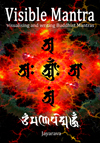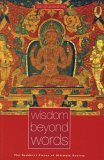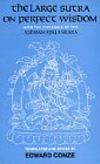
hṛ da ya
This is the mantra from the Prajñāpāramita Hridaya Sūtra or Heart Sūtra. Prajñāpāramita the bodhisattva has another mantra. To see the whole Heart Sutra in siddham script look here.
Traditionally thought to be a Sanskrit text, it now seems almost certain that the Heart Sūtra was composed in China around the 7th century, although it incorporates verses from the Chinese version of the Large Prajñāpāramita texts. It is entirely possible that Xuanzang back translated it into Sanskrit during his trip to India. The evidence for this conclusion are presented in an article by Jan Nattier: The Heart Sūtra : a Chinese apocryphal text? Journal of the International Association of Buddhist Sudies. 1992 Vol. 15 (2), p.153-223. I have a precis of this article on my blog.
Mantra
Siddhaṃ

Tibetan - Uchen

Transliteration
ga te ga te pā ra ga te pā ra saṃ ga te bo dhi svā hā
gate gate pāragate pārasaṃgate bodhi svāhā
Notes on the Heart Sutra Mantra
Conze's translation reads: "gone, gone, gone beyond, gone altogether beyond, oh what an awakening, All hail!"
There has been much speculation on the meaning of this particular mantra. Gate has been analysed as Classical Sanskrit. Conze was of the opinion that gate is in the feminine vocative case. The vocative case indicates that someone is being addressed. so that gate means not simply 'gone', as it is usually translated, but "O she who is/has gone!".
I am not entirely convinced by Conze. There are six ways to derive 'gate' from the verbal root √gam. We may either take it to be a past passive participle or a past active participle. In either case it may be a masculine or neuter locative, or a feminine vocative. A passive participle of the word gata would mean in English ‘he/she/it who is gone to’; while the active would translate as ‘he/she/it who went’. I summarise the possibilities in the table below.
| past passive participle | masc loc | in/on he who is gone to. |
| neut | in/on it that is gone to. | |
| feminine | in/on she who is gone to. | |
| past active participle | masc | in/on he who went |
| neut | in/on it that went | |
| feminine | in/on She who went |
You will see that none of these six options matches Conze’s translations. This is because Conze is giving the particple a perfect aspect. Participles are imperfect unless they are part of a relative clause, when there is a finite verb. “O she who is gone” would need to be something like “gate abhavat” with the verb “to be”. So Conze is seemingly in error in this case.
All this presumes that gate is Classical Sanskrit. In my online essay I have explored the possibility that the –e ending is simply a nominative in either Buddhist Hybrid Sanskrit or Magadhi. In which case it would simply mean: “he who is gone”. The fact is that we don’t know and that all of the explanations we have are ad hoc.
It is common-place for Buddhist dhāraṇī to use this device. Later tradition interprets it as addressing Prajñāpāramita (ie Wisdom, considered feminine in India), most scholars seem to accept that the fem. voc. is intended. Kern, in his 1884 translation of the Sadharmapuṇdarika Sūtra, related the use of the fem. voc. in dhāraṇī to the worship of Durga.
The Heart Sutra itself describes the mantra as "Mahāmantro, mahā-vidyā mantro, ‘nuttara mantro samasama-mantraḥ" which Conze translates as "The great mantra, the mantra of great knowledge, the utmost mantra, the unequalled mantra, the allayer of all suffering". These are traditional epithets for the Buddha, so the mantra is being likened to, or equated with, the Buddha.
There are many commentaries to the Heart Sutra which attempt explanations of the mantra. Seven are recorded in the Tibetan canon. However as Alex Wayman notes:
"One feature of these commentaries [in Tibetan] on the Heart Sutra struck me quite forcibly: each commentary seemed so different to the others, and yet they all seemed to show in greater or lesser degree the influence of the Mādhyamika school of Buddhist philosophy. The writers seemed to be experiencing some difficulty in exposition, as though they were not writing through having inherited a tradition about the scripture going back to its original composition, but rather were simply applying their particular learning in Buddhism to the terminology of the sutra". - Wayman. Secret of the Heart Sutra p.136
and, having surveyed the Indian commentaries preserved in the Tibetan Canon, as well as some of the later Tibetan commentaries, Donald Lopez concludes:
"The question still remains of the exact function of the mantra within the sutra, because the sutra provides no such explanation and the sadhanas make only perfunctory references to the mantra". Lopez. The heart sutra explained. p.120.
A tradition which seems to originate with Atiśa (982-1054) relates the parts of the mantra to the stages of the path as set out in the Abhisamayalamkara (attributed to Maitreya):
| gate | Path of merit / accumulation |
| gate | Path of preparation |
| paragate | Path of insight (1st Bodhisattva bhumi) |
| parasamgate | Path of meditation (2nd to 10th Bodhisattva bhumis) |
| bodhi | Buddhahood |
(Thanks to Ben for pointing this last out to me)
Prajñāpāramitāhṛdaya Heart Sutra Essays
- The Heart Sūtra - Indian or Chinese? (17 Sep 2007) Precis of Jan Nattier's 1992 article on the provenance of the Heart Sutra.
- Words in mantras that end in -e (6 Mar 2009) The Grammatical function of the -e case marker in mantras, suggesting that this is from Prakrit and indicates a masculine nominative singular.
- Tadyathā in the Heart Sūtra (13 Nov 2009) Grammar and syntax of tadyathā in relationship to mantras. Not originally intended to be included in recitation.
- Some Additional Notes: The -e ending in mantras (30 Jul 2010) Further note on the -e ending which shows that it was in widespread us as nominative singular in Northern India [Signe Cohen].
- Heart Sutra Syntax (23 Nov 2012) Initial notes on a grammatical error discovered in Conze's critical edition of the Sanskrit Heart Sutra, with proposed changes to the text. Now submitted to an academic journal.
- Heart Sutra: Horiuzi Palm-leaf mss. Transcription (5 Dec 2012) An important Sanskrit manuscript of the Heart Sutra.
- Emptiness for Beginners (14 Feb 2013) Brief explanation of the concept of emptiness based on close study of Nāgārjuna's Mūlamadhyamkakārikā.
- Heart Sutra Mantra (30 Aug 2013) Detailed notes on the source texts for the mantra found in the Heart Sutra. Definition of mantra vs dhāraṇī with suggestion that the "mantra" is in fact a dhāraṇī.
- Heart Sutra Mantra Epithets (6 Sep 2013) Notes on the epithets often associated with the mantra. Shows that "mantra" is probably the wrong Sanskrit word, and that the source texts, particularly Pañcaviṃśatisāhasrikā Prajñāpāramitā Sūtra has "vidyā". Epithets are in fact unrelated to the dhāraṇī and refer to prajñāpāramitā more generally.
- Who Translated the Heart Sutra into Sanskrit? (13 Sep 2013). Using idiosyncracies in the language to place limits on who could have translated it from Chinese to Sanskrit.
- Fixing Problems in the Sanskrit Heart Sūtra. (20 Sep 2013). Given the problems created by translating from Chinese into Sanskrit, how would we improve on the present sutra.
- A New Sanskrit Heart Sutra (27 Sep 2013). A revision of the edition of the Heart Sutra by Edward Conze, with some back story, notes and a new translation.
- An Alternate Sanskrit Heart Sutra. (11 Oct 2013). A speculative text based on extracts of the Gilgit manuscript of the Pañcaviṃśatisāhasrikā Prajñāpāramitā Sūtra.
- Why is there a Dhāraṇī in the Heart Sūtra? (18 Oct 2013) Looking at dhāraṇī, attitudes of scholars and the role of magic in Buddhism through the lens of Ariel Glucklich's work.
- Variations in the Heart Sutra in Chinese (25 Oct 2013) Examining a critique of Jan Nattier's Chinese origins thesis ont he basis of variant readings in the Chinese Tripiṭaka
- The Act of Truth in Relation to the Heart Sutra (1 Nov 2013) Description of the saccakiriya or act of truth, an obscure branch of Buddhist lore and how it might inform the use of a text like the Heart Sutra






